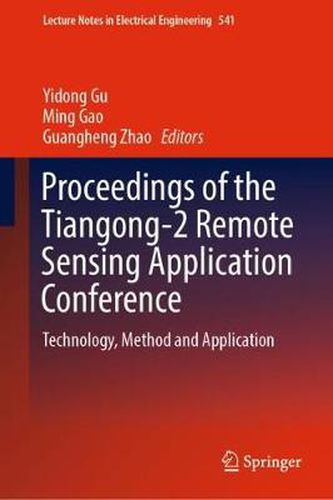Readings Newsletter
Become a Readings Member to make your shopping experience even easier.
Sign in or sign up for free!
You’re not far away from qualifying for FREE standard shipping within Australia
You’ve qualified for FREE standard shipping within Australia
The cart is loading…






This title is printed to order. This book may have been self-published. If so, we cannot guarantee the quality of the content. In the main most books will have gone through the editing process however some may not. We therefore suggest that you be aware of this before ordering this book. If in doubt check either the author or publisher’s details as we are unable to accept any returns unless they are faulty. Please contact us if you have any questions.
This book gathers a selection of peer-reviewed papers presented at the Tiangong-2 Data Utilization Conference, which was held in Beijing, China, in December 2018. As the first space laboratory in China, Tiangong-2 carries 3 new types of remote sensing payloads - the Wide-band Imaging Spectrometer (WIS), Three-dimensional Imaging Microwave Altimeter (TIMA), and Multi-band Ultraviolet Edge Imaging Spectrometer (MUEIS) - for observing the Earth. The spectrum of the WIS covers 18 bands, from visible to thermal infrared, with a swath of 300km. The TIMA is the first-ever system to use interferometric imaging radar altimeter (InIRA) technology to measure sea surface height and land topography at near-nadir angles with a wide swath. In turn, the MUEIS is the world’s first large-field atmospheric detector capable of quasi-synchronously detecting the characteristics of ultraviolet limb radiation in the middle atmosphere. The Earth observation data obtained by Tiangong-2 has attracted many research groups and been applied in such diverse areas as land resources, water resources, climate change, environmental monitoring, agriculture, forestry, ecology, oceanography, meteorology and so on. The main subjects considered in this proceedings volume include: payload design, data processing, data service and application. It also provides a comprehensive introduction to the research results gleaned by engineers, researchers and scientists throughout the lifecycle of the Tiangong-2 Earth observation data, which will improve the payload development and enhance remote sensing data applications.
$9.00 standard shipping within Australia
FREE standard shipping within Australia for orders over $100.00
Express & International shipping calculated at checkout
This title is printed to order. This book may have been self-published. If so, we cannot guarantee the quality of the content. In the main most books will have gone through the editing process however some may not. We therefore suggest that you be aware of this before ordering this book. If in doubt check either the author or publisher’s details as we are unable to accept any returns unless they are faulty. Please contact us if you have any questions.
This book gathers a selection of peer-reviewed papers presented at the Tiangong-2 Data Utilization Conference, which was held in Beijing, China, in December 2018. As the first space laboratory in China, Tiangong-2 carries 3 new types of remote sensing payloads - the Wide-band Imaging Spectrometer (WIS), Three-dimensional Imaging Microwave Altimeter (TIMA), and Multi-band Ultraviolet Edge Imaging Spectrometer (MUEIS) - for observing the Earth. The spectrum of the WIS covers 18 bands, from visible to thermal infrared, with a swath of 300km. The TIMA is the first-ever system to use interferometric imaging radar altimeter (InIRA) technology to measure sea surface height and land topography at near-nadir angles with a wide swath. In turn, the MUEIS is the world’s first large-field atmospheric detector capable of quasi-synchronously detecting the characteristics of ultraviolet limb radiation in the middle atmosphere. The Earth observation data obtained by Tiangong-2 has attracted many research groups and been applied in such diverse areas as land resources, water resources, climate change, environmental monitoring, agriculture, forestry, ecology, oceanography, meteorology and so on. The main subjects considered in this proceedings volume include: payload design, data processing, data service and application. It also provides a comprehensive introduction to the research results gleaned by engineers, researchers and scientists throughout the lifecycle of the Tiangong-2 Earth observation data, which will improve the payload development and enhance remote sensing data applications.